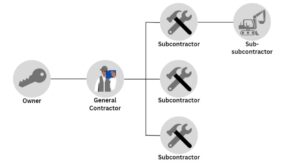In this article, we will delve into the following key topics:
Definition and Purpose of Subcontracts:
Types of Subcontract Agreements:
o Fixed price contracts
o Cost-reimbursable contracts
o Time and materials contracts
o Unit-price contracts
Difference Between Contractors and Subcontractors:
o Primary contractor's role and responsibilities.
o Subcontractors' specialized tasks and supervision.
How Subcontracting Works:
Types of Subcontractors:
o Site preparation
o Structural and framing
o Concrete
o Plumbing
o Roofing, siding, and sheet metal work
o HVAC
o Electrical
o Carpentry
o Stonemasonry
o Painting
o Tiling
o Drywall
o Carpet Installers
Pros and Cons of Subcontract Agreements:
Importance of Legal Assistance in Subcontract Agreements:
A subcontract is a contract that assigns a portion of the work or responsibility for fulfilling a
project between a prime contractor and a subcontractor. The subcontractor may be
contracted to perform a larger portion of the work or to fulfil a specialised responsibility.
Regarding the project, the agreement outlines each party's duties, responsibilities,
expectations, time restraints, and salary. The agreement also covers, among other things,
information on warranties, insurance requirements, dispute resolution processes, and
intellectual property rights.
The effective completion of a project, or a portion of a project, is the common objective in
subcontract agreements. Subcontract arrangements vary widely in this regard, catering to
the differing requirements of the involved parties.
The most common types of subcontract agreements are:
• Fixed-price contracts: these function best when there are unambiguous expectations
and defined scope and involve both parties agreeing on a fixed price for the goods or
services to be given;
• Cost-reimbursable contracts: these are employed when there is ambiguity regarding
the project's specifications or expenses and allow the subcontractor to recover costs
based on receipts and other documentation;
• Time and materials contracts: these are perfect for projects with erratic deadlines or
unpredictably prohibitive costs since they set an hourly fee for the labour and
materials required to finish the job; and
• Unit-price contracts: these work effectively for buying copious quantities of standard
commodities, such as building materials, since they outline the prices per unit of work
accomplished or supplied.

What is the difference between contractors and subcontractors?
A primary contractor collaborates closely with the principal to deliver the goods or services
specified in the contract and can be either individuals or businesses. The independent
contractor, on the other hand, engages a subcontractor to assist in conducting a contract
they have with the principal.
A primary contractor, also known as a general contractor, is hired by the client to oversee the
completion of the construction work. They are responsible for keeping an eye on the building
site daily, managing contractors and suppliers, and informing relevant parties of
developments. As the project's point of contact, the general contractor is in charge of
locating supplies, labour, and machinery, as well as undergoing construction work in their
specialised areas of expertise.
Conversely, subcontractors are experts employed by the general contractor to conduct
specific tasks. They do not have direct communication with the client, rather they operate
under the general contractor's supervision and guidance. Typically, subcontractors have
expertise in particular aspects of construction, such as roofing, plumbing, or electrical work.
How does subcontracting work?
Primary contractors delegate specific tasks to subcontractors, to complete the project with
diverse capabilities. Typically, a contractor gets hired for a building project where the project
calls for work in a specialised area, such as electrical or insulation, and the contractor may
contract out that work to a subcontractor.
The subcontractor works together and reports to the primary contractor, offering their
specialist skill set in exchange for a contractual fee, while the contractor maintains contact
with clients. Generally speaking, subcontracting is used when a project requires a variety of
capabilities that cannot be completed by a single general contractor.
Types of subcontractors:
Site preparation:
Some primary contractors will employ a site preparation contractor to get the site ready
before the project commencement. This may consist of levelling the land, clearing the
vicinity, and transporting large machinery to the location.
Structural and framing:
A contractor may be hired to manage the wood, steel, or concrete structural components for
the project, inclusive of walls and roofs.
Concrete:
A contractor may be hired to pour the foundation, footings, and other cementitious structures
such as driveways and walkways. They might also be called upon to install precast concrete
culverts, beams, and walls.
Plumbing:
Plumbing contractors will install waste lines, vents, tanks, and water pipes. They also tie into
the city water lines or well water.
Roofing, siding, and sheet metal work:
Contractors in this field will usually dry in the building envelope and work with prefabricated
materials to be able to move quickly to enclose the building so interior build-out can begin.
Heating, Ventilation, and Air Conditioning (HVAC):
The safe and comfortable environment of a building's occupants is the responsibility of
HVAC subcontractors. To maintain the building's comfort, these contractors will install air
conditioners, ducting, boilers, furnaces, and other mechanical equipment.
Electrical
Panels, wires, fixtures, generators, transfer switches, and other electrical equipment are
installed by electrical contractors. They might also be in charge of putting up temporary
electricity to be used while construction is occurring.
Carpentry
Carpenters usually work on the interior finishes for the project such as trims, cabinetry,
interior doors, floors, and decorative interior accents.
Stonemasonry:
A stonemason creates structures, buildings, and sculptures using bricks and stone
surfaces. They work with different stone materials, such as marble and limestone, and
employ a range of tools and techniques to shape, cut, and fit the material into the
appropriate shape and size.
Painters:
Painting contractors are experts at painting both the interior as well as the exterior of the
construction project. They use techniques like caulking, sanding, masking, and painting to
get the desired look.
Tiler:
Tiling contractors typically cover the interior surfaces of a project using materials such as
slate, marble, ceramic, and glass. This is usually done on the floors, in the kitchen and
bathrooms. Additionally, they specialise in external tiles for gardens, patios, terraces, and
swimming pools. They might also specialise in installing vinyl or wood flooring, among other
kinds of flooring.
Drywall:
In most building projects, whether they are residential or commercial, drywall contractors are
necessary. They are in charge of attaching drywall panels to the wall and ceiling structure,
fastening the panels firmly with joint tape and screws.
Carpet Installers:
These contractors install carpet, which is a type of flooring made from woven fibres, popular
in bedroom and lounge room settings.
Pros and Cons of Subcontract Agreements:
Pros:
Access to specialised skills and expertise which may not be available in-house,
ensuring a high-quality work standard;
Provides flexibility in resource allocation;
Risks are reduced by sharing responsibilities and experience; and
Subcontractors typically supply their own tools and equipment, sparing the primary
contractor from making further investments.
Cons:
The terms and obligations of the contract may give rise to disputes;
The subcontractor may have difficulties adhering to safety requirements or protecting
intellectual property;
Dependencies on subcontractors can cause uncertainty in project deadlines and
completion dates; and
Consistency in quality across subcontractors can be difficult to ensure without
continuous direct monitoring.
Why get a lawyer to draft and review your subcontract agreement?
A well-written subcontract is essential for safeguarding the interests of both parties and
assisting in the prevention of disputes or miscommunications. If a client raises a concern
about the work done, or if the parties' relationship were to break down, a well-written
subcontractor agreement can help to reduce the risk of harm and liability.
Lawyers are also taught to interpret the law and its practical ramifications, especially when it
comes to terms that could be considered unjust. Our lawyers at Elamine Lawyers will be
able to advise you on any key legal risks and issues within the contract. In addition to
warning, you about the risks, our lawyers can assist you in comprehending the terms of the
contract and the responsibilities that are placed on you as the principal contractor and any
subcontractors.
for this reason, it is essential for both the primary contractor and the subcontractor to have a
concise and comprehensible subcontractor agreement. Furthermore, well-written
subcontractor agreements can save a great deal of time, money, and frustration for both
parties by guarding against ambiguity.
Whether you wish to review an existing contract or want help drafting one, Elamine Lawyers
is the place for you. Contact us today at admin@elaminelaw.com.au or call us on 03 8400


Quisquam officia, dapibus lacus reiciendis elit nostra nascetur voluptatum quis incididunt, ut, hendrerit cumque magni dicta, mollit tellus quis incididunt, ut, hendrerit cumque.
Dolorem laoreet rerum consequuntur impedit excepturi ipsa maiores eos platea impedit ab molestie nascetur, porro.
Dolorem laoreet rerum consequuntur impedit excepturi ipsa maiores eos platea impedit ab molestie nascetur, porro.
Dolorem laoreet rerum consequuntur impedit excepturi ipsa maiores eos platea impedit ab molestie nascetur, porro.
TALK TO AN EXPERT !.